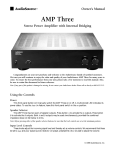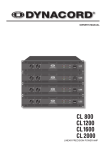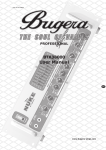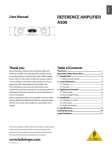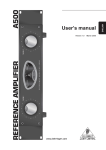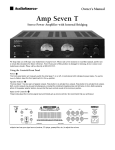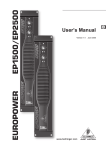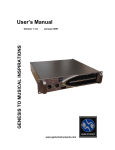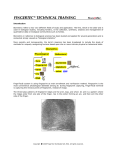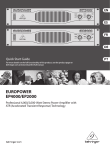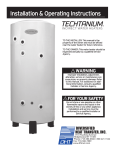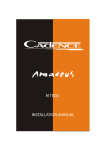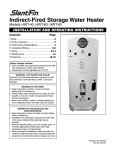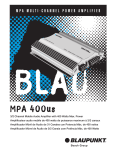Download Cadence MONO CLASS D User's Manual
Transcript
MONO CLASS D AMPLIFIERS 2 INTRODUCTION Thank you for purchasing a Cadence Type RS amplifier. Over the past years, the technology used to create audio amplifiers has grown by leaps and bounds. We have thousands of satisfied customers still using our first generation Ultra Drive amplifiers which are almost 10 years old. Our competition is satisfied with just continuing to build the same units year after year without thought for improvement, but not us. We consider it our mission to use our expertise in developing the latest technologies and to bring you the absolute best sounding, most powerful amplifiers on the market and of course at a reasonable price. We are very proud to introduce this seventh generation of Type RS amplifiers featuring C-FORCE technology, "ARVA" and "ADR" circuitry. You will be amazed at the quality and power that these new amps offer. You will "Boom-Harder!" with Type RS amplifiers. We have spared no expense in designing these amplifiers, creating the most rugged, reliable, powerful and best performing amplifiers. In fact we are so sure of the quality we backup every Type RS amplifier with our exclusive two-year warranty which exemplifies our commitment to excellence in car audio musical reproduction. (See enclosed warranty card for details.) Please read this installation guide carefully for proper use of your Cadence power amplifier. Should you need technical assistance during or after your installation please call our technical-line between 9:30 am and 5:00 PM EST at 732/370-5400. Read this entire guide fully before attempting your installation. WARNING: BE AWARE! Use of this amplifier at extreme high volumes for extended periods of time may cause hearing loss and or hearing damage. During periods of prolonged high volume levels it is recommended that you use ear safety devices. Playing Cadence amplifiers at high volume levels while driving will impair your ability to hear necessary traffic sounds. While driving always keep your sound volume at reasonable levels. We at Cadence want you listening for many years to come. When installing the amplifier, secure it tightly. An unmounted amplifier in your car can cause serious injury to passengers and damage to your vehicle if it is set in motion by an abrupt driving maneuver or short stop. Boom Harder! FEATURES GOLD PLATED TERMINALS: All the terminals on the amplifier are solid brass and satin nickel plated for high conductivity and minimum impedance loss. The power and ground terminals are extra large and capable of accepting 2 gauge wire. The speaker terminals can accept 8 gauge wire. When wiring the amplifier, be sure to strip just enough wire that fits into the terminal so that bare wires do not touch each other, or the amplifier chassis and cause a short circuit. POWER AND PROTECTION CIRCUITRY: Type RS amplifiers feature our unique IC controlled protection circuitry. This sophisticated circuit constantly monitors the heatsink internal temperature and various voltages, adjusting the amp automatically and protecting it from dangerous conditions. The 2 LEDs located on the input side of the amplifier provide indication of the amplifier status, and the Power LED will light Green when the amplifier is receiving proper power, ground and remote voltages and the IC monitoring sequence indicates the amp is functional. In case the amplifier encounters a diagnostic condition as listed below, the second LED will turn RED indicating a Diagnostic condition. When a diagnostic condition is sensed the amplifier will then turn into a self preservation mode and if the cause of the diagnostic condition is not corrected will eventually shut off. There are certain critical diagnostic conditions which will turn the amplifier off immediately. 3 BASS DRIVE EQUALIZATION CIRCUITRY: A narrow "Q" shelving equalization circuit is included in the amplifiers. The equalization system allows you to choose the center frequency which you want to boost and also a separate adjustable boost control. This boost control allows you to add up to 15dB of Bass Drive effect. Utilize the Bass Drive to tailor your bass response to your systems needs. Please keep in mind that adding Bass Drive you are adding stress on your speakers. Make sure your speakers can handle the extra power output! It would be foolish to add 15dB of gain to low excursion 8" and 10" subwoofers. “ADR”: - ACTIVE DYNAMIC REGULATION Cadence RS amplifiers feature our proprietary ADR, Active Dynamic Regulated power supplies. 100% HexFET devices are utilized in the power supply for high speed (100KHz) switching frequencies. The power supplies are capable of supplying the main amplifier with a considerable amount of reserve voltage for peak "high demand" situations. The ADR circuit provides full bandwidth power for authoritative bass response, high current output into low impedance loads and increased headroom. The ADR is supplied with power via a high speed, high temperature capacitance bank and 100% pure copper rails on the PCB enabling fast transient response to musical demands. 1. Speaker short circuit. 2. Input Overload. CLASS D AUDIO STAGE PERFORMANCE 3. Thermal overload. 4. Reverse Polarity. To reset the amplifier, you must first diagnose what caused the problem, correct the fault and restart the system. See the Trouble Shooting page for further details. STIFFENING CAPACITOR DIRECT CONECTION: The audio output section of the RS amplifiers feature high speed high voltage, low Rdson MosFET transistors. This design contributes to ultra low distortion and extreme high power capabilities. Our proprietary Class D modulation scheme, in conjunction with a very carefully designed output filter, ensure clean, accurate sound reproduction with authority for deep slamming true bass. YOU WILL HEAR THE DIFFERENCE. A unique feature of the Cadence Type RS amplifiers, is their direct capacitor connection to the amplifier's internal power supply. As you know, the speed in which the reserve capacity of any stiffening capacitors reaching the amplifier's power supply is critical. You want this reserve voltage to be immediately available upon your amps hitting a bass note. Our terminal connection puts the negative of the capacitor in direct line with the negative terminals of the power supply MosFET's and the positive of the capacitor with the center tap of the power supply transformer coil. In essence, it's like your amplifier having its own personal battery. MUTE CIRCUIT: The RS amplifiers feature an anti-thump, mute and delay circuit. This eliminates irritating and speaker damaging turn-on and turn-off transients normally experienced with less expensive amplifiers. Boom Harder! 4 FEATURES AMPLIFIER MODE SWITCH This switch enables you to slave multiple RS amplifiers off one master. Input signal will be connected to the master in a system, and then a PM2 bridging cable can be used to connect the master out to the slave in of a second amplifier, and in multiple amplifier systems, this amplifier’s master output can be connected to a third amplifier’s slave input, thus allowing the daisy chaining of an almost unlimited number of amplifiers from one signal source. In addition, a single Competition Podium Remote control (CPR) can optionally be connected to the master amplifier, in order to control all the slave amplifiers connected to it. Note that when an amplifier is set in the SLAVE mode, its level control, phase shift, subsonic filter, bass EQ, low pass filter, as well as remote control function will be totally bypassed, as these functions will be controlled by the master amplifier to ensure perfect level and spectral matching between all amplifiers. INDUCTION AND TUNNEL FAN COOLING: Due to the extreme high power capabilities of these amplifiers, they feature a built-in induction fan cooling system. The amplifiers draw in cool air through the nosepiece side vents, for circulation across the circuitry. The main heatsink for the amplifier and power supply sections is a CAD designed forced cooled tunnel that runs the length of the amplifiers. A fan at each end, one pulling air in, and the other forcing air out, ensure that the power electronics stay cool for continued, clean operation. It is important not to block either the input or exhaust ports. Some of our competitors are more interested in making a quick buck and will purposely leave the fan out of their amps and then charge you a hefty sum to buy and add the fan on later. At Cadence, if we feel that our amplifiers will work better with a fan then we install it at the factory and don't make it an expensive add on option. PROTECTION CIRCUITRY: Cadence amplifiers incorporate many outstanding protection circuits to help protect the amplifier from being damaged during operating conditions. “ARVA” - AUTOMATIC RAIL VOLTAGE ADJUSTMENT CIRCUITRY: Cadence RS amplifiers feature "ARVA" circuitry in their power supply. This circuit constantly monitors the output stage and under high current demands will adjust the power supply rail voltages so that enough power is available for peak situations. The "ARVA" also improves the damping factor of the amplifier when playing low impedance mono loads. Cadence Type RS amplifiers have tighter sounding bass reproduction thanks to this unique circuitry. BATTERY VOLTAGE: Cadence RS amplifiers are rated and regulated to 13.8 volts and below. Increasing voltage to 14.4 volts will increase the power output of the amplifier in the same proportion. Maximum input voltage is 16 volts while the minimum voltage is 12 volts. Thermal Protection: When the amplifier reaches an unsafe operating temperature of 80 degrees Celsius the amplifier will turn off. Once the amplifier cools down, simply reset the amplifier by its Remote connection, (turn the amplifier off and then on again once you have given the amplifier a chance to cool down) and the amp will once again begin to play. If you live in a hot climate we suggest installing additional cooling fans in your trunk to exhaust the hot air which can build up in the trunk this will help keep the ambient temperature in the trunk as low as possible so that your amps work flawlessly and without any musical interruption. Speaker Short Circuit Protection: Should your speakers short circuit due to voice coil burn out, or should the amplifier sense an impedance too low to handle, the Protection LED will light, indicating a diagnostic condition. Turn off your system, disconnect one speaker at a time and try to determine which speaker might be faulty. Correct the condition and restart the amplifier. You must reset the amplifier by turning off and then on by the Remote power for proper operation after correcting a diagnostic condition. Clipping or total shutdown may also be a result of a bad ground connection or loose ground. If you find that your speakers and speaker wires are not shorted, please check your ground connection. Input Overload Protection: This circuit will either shutdown the amplifier completely or make the amplifier spurt on and off indicating that it is in a diagnostic condition. Turn the system off and reduce the gain on the amplifier or volume from your head unit, this should result in a corrected condition. Boom Harder! DC Offset Protection: Should any DC voltage try to enter the amplifier via the speaker terminals it will cause the amplifier to shut down and not operate until this condition is remedied. This circuit will also protect damaging high DC voltages from reaching your speakers should your amplifier ever miss-function. INSTALLATION BASICS INSTALLATION BASICS: Before you begin with your installation disconnect the NEGATIVE (-) terminal from your car's battery. This safety precaution will avoid possible short circuits while wiring your amplifier. Cadence amplifiers operate on 12-volt negative ground systems only. It is recommend that you layout your sound system design on paper first. This will help you during the installation so that you will have a wiring flow chart and not miss-wire any of your components. Mount the amplifier in the trunk or hatch area of your vehicle. Never install an amplifier in the engine compartment or on the firewall. Please be sure to leave breathing room around the amplifier heatsink so that it can dissipate the heat it produces efficiently. The amplifier can be installed either horizontally or vertically. When mounting the amplifier on the trunk floor, be sure to watch for your gas tank, gas lines and electrical lines. Do not drill or mount any screws where they might penetrate the gas tank of your car. POWER/GROUND WIRING: 5 REMOTE TURN ON CONECTION: The remote turn on connection is located on the barrier strip next to the power and ground connections. This connection is responsible for turning the amplifier on and off with the rest of the system. A smaller gauge wire can be used to make this connection to your radio's power antenna lead. Should your system not have any turn on leads, you can wire the remote terminal to an accessory lead, which turns on, with your ignition. STIFFENING CAPACITOR DIRECT CONNECTION: The benefits of this feature have been described earlier in the Features section. Connect the Positive terminal of the capacitor to the terminal marked (+) on the amp and the negative terminal of the capacitor to the terminal marked (-). Use the heaviest gauge wire available for this connection. We recommend using Cadence Extreme Series Power Capacitors due to their industry leading low ESR rating. Multiple capacitors can be connected via BUS BAR terminals for larger amplifier installations. Use a CAP-1DR per amplifier model ZRS-8, a CAP2DR per amplifier model ZRS-9, and a CAP5DR for amplifier model ZRS-10. USING THE RS AMPLIFIERS IN CONJUNCTION WITH A MULTI- CHANNEL AMPLIFIER: The RS amplifiers are supplied with ANL fuse blocks, and we suggest you construct a Red wiring harness with 1 additional fuse. One fuse should be located near the car battery. This fuse near the battery offers protection against damage from short circuits to the car chassis between the battery and the amplifier. A second fuse closer to the amplifier offers additional safety to the amplifier itself. This fused red power wire should be attached to the amplifier power terminal marked 12V+. The RS amplifiers are of course meant for sub bass applications, and as such need to be used in conjunction with a second amplifier for a complete full range system. The wire harness should be made of red primary cable of at least 4 gauge. The harness should terminate in a large ring terminal for connection directly to the positive terminal of the car battery. Use a spade plug to attach the wire, which connects to the amplifier location marked 12V+. Set the multi-channel amplifier’s internal crossover to High Pass, as it will drive the high frequency speakers, such as separates, coaxials, or plate type speakers, typically mounted in the doors or kick panels. A second black color wire of equal gauge should be used as a ground connection to a welded chassis member. When connecting the ground wire make sure that there is no paint or other insulator blocking a good ground connection. When installing multiple amplifiers, mount them in close proximity so that they can all share the same ground point. Attach the black ground wire to the amplifier screw terminal marked Ground. Refer to the wiring diagram on Page 6. Connect the Line Out of the RS amplifier to the Line Input of a multi-channel amplifier. Mount a master fuse right at the battery + terminal as shown. Add up the current draw for all amplifiers in the system to determine the rating for this fuse. Use a power distribution block, such as the Cadence FH-1, FH-2 or FH-3 at the amplifier location to supply +12 volt to each amplifier. Connect the remote turn on signal from the source to all amplifier remote turn on terminals. We at Cadence recommend that you use our ZIK-4 amplifier installation kit, which contains all the cabling and accessories necessary for a good, reliable installation. Over the years we have received many an amp back to our service department with melted power/ground terminals. The cause of this is a bad ground connection. When there is a lack of good ground heat builds up at the weakest point which is the contact screw of the terminal. Over time the heat generated will begin to melt the terminal. It is a good practice to feel the power and ground wires with your hands, near their amplifier connection after having played the amp for a while. If the wires feel hot to the touch you probably have a bad or loose connection. If you are sure of your connections and the wires still feel hot to the touch, you should upgrade the gauge of the wire to next heaviest gauge. Boom Harder! 6 MOUNTING MOUNTING THE RS AMPLIFIERS: Choose a convenient mounting location with unobstructed airflow. 1 - Mount and fasten amplifier bracket A onto the mounting surface, with two screws as shown. 2 - Slide the amplifier so that hook B engages with bracket A. 3 - Fasten the front of the amplifier to the mounting surface with screws as shown. 1 A 3 2 A B Boom Harder! BASIC SINGLE RS AMPLIFIER INSTALLATION WITH A 2ND AMPLIFIER FOR THE HIGHS 7 Mode switch Line level inputs from head unit Ground BURST PR POWER FULL POWER Optional Capacitor LEVEL -50 dB FULL POWER BATTERY VOLTAGE CPR Remote Control Stereo RCA cable from RS LINE OUT to highs amp LINE IN 2 CHANNEL HIGH FREQUENCY AMPLIFIER Woofer 1 ohm minimum Remote turn on Fuse at battery Distribution block Boom Harder! Remote turn on Master fuse at battery NOTE: Set the HIGHS amplifier crossover to HIGH PASS Ground High frequency speakers Battery 8 USING THE CPR REMOTE CONTROL WITH THE RS AMPLIFIERS CPR (COMPETITION PODIUM REMOTE) BASICS The optional CPR remote control can be used for street or SPL competitions alike. The CPR is an optional unit and not included with the ZRS amplifiers. Please see your dealer for pricing and availability of the CPR. Apart from the usual level control, it also sports a few extra features that SPL competitors especially will find handy. LEVEL CONTROL: With the level control in the Full Power, or fully clockwise position, the amplifier output will be as set by the level control on the amplifier itself, in other words, no effect on the level. In the 50 dB, or minimum position, the amplifier output level will be attenuated by 50 dB. BURST BUTTON: The BURST button overrides the level control on the CPR in the following manner: When the level control is at Full Power, pressing the BURST button will have no effect at all. When the level control is set to -50 dB or any intermediate position, and the BURST button Is depressed, the amplifier output will instantaneously jump up the level as determined by the amplifier’s level control, regardless of setting. DIGITAL BATTERY VOLTAGE MONITOR: Maintaining a properly charged battery system for competition purposes is critical, and with the Digital Battery Voltage Monitor on the CPR, a competitor can conveniently check the battery status during burps. POWER BARGRAPH: The 5 LED Power Bar-Graph on the CPR indicates the relative amplifier power output in real time, so that the competitor can be sure that the system is delivering as much power to the speakers as possible. INSTALLATION: Please refer to the wiring diagrams on pages 7, 10 and 11 on using the CPR with single, dual mono bridged and multiple RS amplifier systems. Use the supplied 8 pin cable to connect it to the appropriate jack on the amplifier. Boom Harder! Be sure to use the cable which came with the CPR. Do not substitute cables. ADJUSTING THE SYSTEM 9 SETTING THE TOP PANEL CONTROLS ADJUSTING THE SYSTEM AUDIO PREAMP INPUT The RS amplifiers feature RCA preamp inputs. Run RCA cables from your sound source to the inputs of the amplifier. We suggest the use of high quality shielded RCA patch cords to help reduce and eliminate unwanted electrical noise from your system. Be sure to run the RCA cables on the opposite side of the vehicle that you used to carry the power and ground leads of the amplifier. AUDIO PREAMP OUTPUT The RS amplifiers feature RCA preamp outputs which can be used to signal feed secondary amplifiers in your system without the use and expense of "Y" adaptors. The preamp output is full range. USING THE BUILT-IN LOW PASS ELECTRONIC CROSSOVER All the RS amplifiers feature 24dB per octave fully adjustable low-pass crossovers. Set the frequency adjustment knob marked LOW PAS FILTER to adjust the filter frequencies. SUBSONIC FILTERING. Your RS amplifier is capable of subsonic filtering. This feature is useful for today's popular bandpass or vented subwoofer enclosures. The subsonic filter acts as a High Pass crossover blocking the unwanted signals from reaching specific speakers. This helps to control the mechanical excursion of the woofers at very low frequencies, thus causing a cleaner sound, better utilization of amplifier power and improved speaker reliability. PHASE SHIFT CONTROL The Phase Shift control on the RS amplifiers allows you to adjust acoustical integration between the sub bass and higher frequency speakers in a system. Adjust this control for best audible results. AMPLIFIER MODE SWITCH This switch enables you to slave multiple RS amplifiers off one master. Set it to MASTER for single RS amplifier, or first of a multiple RS amplifier systems. In multiple RS amplifier systems, set this switch to SLAVE for any amplifiers slaved off a master. Once the system is operational, the first thing to do, is set all crossover points to approximate settings. In the case of the basic system described on Page 6, start off with the RS amplifier Low Pass filter, and the highs 2 channel amplifier’s internal crossover at 100 Hz or so. Set all equalizer controls to 0 dB Now you should set the amplifiers LEVEL adjustment. The knob accessible on the top of the amplifier marked Input Level adjusts the input sensitivity from 200mV to 9Volts. To adjust the input sensitivity, turn the control using a small flat head screwdriver fully counter clock wise to the 9volt minimum position. Do not apply any pressure while turning as this might break the control unit. Adjust your radio volume level to maximum volume. Now turn the level control on the amplifier clockwise towards 200mV marking and until audible distortion occurs. When you begin to hear any distortion in the sound back down one notch and your amp is set. It is helpful to have a second person to help you set the gain. When setting up a multi-amp system, set each amplifier’s gain separately. Start off with the bass amplifier, then adjust the highs amplifier’s level control to match. Once you’re satisfied with the level control settings, use the equalizer controls to adjust the system tonal level for personal preference. Keep in mind that after equalizing, you may have to go back and reset the level controls. The level control of any car amplifier should not be mistaken for a volume control. It is a sophisticated device designed to match the output level of your source unit to the input level of the amplifier. Do not adjust the amplifier gain to maximum unless your input level requires it. If your unit has been professionally installed please do not change the gain settings set by the installer, he is the professional! Your system can also be extremely sensitive to noise when the LEVEL is set to maximum and does not match your input signal. The gain adjustments need to be made only once when first setting up the system. Boom Harder! 10 MONO BRIDGING 2 AMPLIFIERS INTO 1 WOOFER MASTER/SLAVE CONNECTION DIAGRAM Mode switch IMPORTANT: Link between 2 amplifier - speaker terminals #14 minimum BURST POWER PR 2 ohm minimum FULL POWER LEVEL -50 dB FULL POWER Ground BATTERY VOLTAGE Pm2 Cable Distribution block Mode switch Master fuse at battery NOTES ON MONO BRIDGING 2 RS AMPLIFIERS INTO ONE SPEAKER LOAD Ground AMPLIFIER MODE SWITCH, INPUTS AND REMOTE CONTROL Battery Set the AMPLIFIER MODE switches as shown Connect the source to the master amplifier inputs, and an optional CPR remote control to the master, as shown. Use a PM2 bridging cable to connect the master output of the first amplifier to the slave input of the second. Connect the speaker as shown, with the link between the negative speaker terminals of the two amplifiers. Connect the ground terminal with as short a piece of cable as possible to the nearest metal chassis point. Mount a master fuse right at the battery + terminal as shown. Add up the current draw for all amplifiers in the system to determine the rating for this fuse. Boom Harder! Use a power distribution block, such as the Cadence FH-1, FH-2 or FH-3 at the amplifier location to supply +12 volt to each amplifier. Connect the remote turn on signal from the source to all amplifier remote turn on terminals. SYSTEMS WITH MULTIPLE AMPLIFIERS NOTES ON MULTIPLE AMPLIFIERS AND SPEAKER PHASE MONOBRIDGING MULTIPLE PAIRS OF AMPLIFIERS 11 MONO BRIDGING MULTIPLE PAIRS OF AMPLIFIERS Mode switch The phase of each monobridged speaker per amplifier pair is the same. See the diagram on the right. 2 OR MORE AMPLIFIERS WITH SEPARATE SPEAKERS ON EACH Please note that for this type of setup, the speaker phase on every alternate amplfier MUST be reversed in order to keep the acoustical phase of all speakers in the system in phase with each other. See the diagram below. Pm2 Cable BURST POWER Mode switch POWER PR Pm2 Cable 1 ohm minimum LEVEL POWER Pm2 Cable Pm2 Cable FULL POWER -50 dB FULL BATTERY VOLTAGE Mode switch IMPORTANT: Link between 2 amplifier - speaker terminals #14 minimum BATTERY VOLTAGE Mode switch 2 OR MORE AMPLIFIERS WITH SEPARATE SPEAKERS BURST 2 ohm minimum LEVEL -50 dB FULL Mode switch PR FULL POWER AMPLIFIER MODE SWITCH, INPUTS AND REMOTE CONTROL The first, or master amplifier switch in these arrangements will of course act as the master in all respects. It will accept the input from the source via RCA cables, and its level control, crossover and filters, as well as remote control, if connected, will control all slaves. Do not forget to set the amplifier Mode switches as indicated on all diagrams. POWER 2 ohm minimum IMPORTANT: Link between 2 amplifier - speaker terminals #14 minimum Mode switch 1 ohm minimum IMPORTANT: Note the reverse speaker phase on 2nd amplifier To the Slave In of the next amplifier IMPORTANT: Reverse the speaker phase on every alternate amplifier Pm2 Cable To the Slave In of the next amplifier pair Boom Harder! 12 BASIC SPEAKER WIRING DIAGRAMS FOR VARIOUS LOADS SERIES: SINGLE VOICE COIL SPEAKERS NOTES ABOUT USING MUTLTIPLE SPEAKERS: Please note that the minimum impedance load for single Cadence Type RS amplifiers is 1 ohm. If you choose to mono bridge two RS amplifiers into on load, the impedance should not be lower than 2 ohm. Lower impedance loads will cause overheating and may damage the amplifiers. Do not use different type and different impedance speakers in the series and/or parallel combinations shown, as unequal power sharing and acoustic outputs will result. + 2 OHM + PARALLEL: SINGLE VOICE COIL SPEAKERS + + 2 OHM TO AMPLIFIER 1 OHM TO AMPLIFIER 4 OHM 4 OHM - SERIES: DUAL VOICE COIL SPEAKERS 8 OHM TO AMPLIFIER - 4 OHM TO AMPLIFIER 2 OHM 2 OHM 2 OHM - + 4 OHM TO AMPLIFIER 2+2 OHM - + 1 OHM TO AMPLIFIER 4 OHM 4 OHM 4 OHM 4 OHM 4 OHM + - 8 OHM TO AMPLIFIER + - + Boom Harder! 4+4 OHM 2 OHM TO AMPLIFIER - 4 OHM 8 OHM 8 OHM 8 OHM 8 OHM 2 OHM TO AMPLIFIER - 1+1 OHM ADVANCED SPEAKER WIRING DIAGRAMS FOR VARIOUS LOADS PARALLEL: DUAL VOICE COIL SPEAKERS 2 X DUAL VC 4 OHM SPEAKERS WITH PARALLEL VOICE COILS, IN PARALLEL 3 X DUAL VC 8 OHM SPEAKERS WITH PARALLEL VOICE COILS, IN PARALLEL + + 2 OHM TO AMPLIFIER + 1 OHM TO AMPLIFIER 4+4 OHM 13 4+4 OHM 2.67 OHM TO AMPLIFIER 4+4 OHM - 8+8 OHM 8+8 OHM 8+8 OHM - - 2 X DUAL VC 2 OHM SPEAKERS WITH SERIES VOICE COILS, ALL IN PARALLEL 4 X DUAL VC 8 OHM SPEAKERS WITH SERIES VOICE COILS, ALL IN PARALLEL + + 1 OHM TO AMPLIFIER 2+2 OHM + 2 OHM TO AMPLIFIER 2+2 OHM 2+2 OHM 2 OHM TO AMPLIFIER - - + - 4+4 OHM 4+4 OHM 4+4 OHM - 2 X DUAL VC 1 OHM SPEAKERS WITH SERIES VOICE COILS, ALL IN PARALLEL 1 OHM TO AMPLIFIER 4+4 OHM 4 X DUAL VC 4 OHM SPEAKERS WITH SERIES VOICE COILS, ALL IN PARALLEL + 1+1 OHM 1+1 OHM 1 OHM TO AMPLIFIER - 2+2 OHM 2+2 OHM 2+2 OHM 2+2 OHM Boom Harder! 14 TROUBLESHOOTING HOW TO TROUBLE SHOOT A SYSTEM GENERAL A car stereo system consists of many different pieces of equipment connected together, and a logical process of elimination will find the problem area, by isolating sections, and checking them one at a time. Before following the instructions below, check and double check all wiring and connections. TOOLS NEEDED The following tools will help in finding problems: A general purpose multi meter, capable of checking voltage and resistance, is perhaps the most useful piece of test gear that any installer can own. You may also need a test speaker, and a head unit, as these will be handy for temporary connection for checking purposes when you are working in the trunk of the vehicle. AMPLIFIER OVERHEATING AND SHUTTING DOWN The most common cause for this problem is when amplifiers are overloaded with speaker impedances lower than what they are rated for. Double-check the impedance of your speakers and their wiring. Also check that no speaker leads are shorted to the vehicle metal chassis. AMPLIFIER GOING INTO PROTECTION When an amplifier goes into protection mode, we have to first establish whether the problem lies with the amplifier, or whether it is something in the installation. Disconnect all RCA and speaker cables, leaving the power, ground and remote connections. Turn the system on, and if the amplifier now powers up properly, add the RCA cables, and see if the amplifier goes into protection. If not, proceed by reconnecting the speaker leads, etc. By following this simple process of elimination, the fault can be diagnosed quite easily. LACK OF BASS NO SOUND The lack of bass can be attributed to various causes. This is probably the most perplexing problem to find. Check that the proper recommended enclosures have been used for the woofers. 1. Reduce the amp gain to 9 volts and unplug the RCA cables and speakers from the amplifier. Check the phasing of multiple woofers connected to one amplifier, as well as those connected to multiple amplifiers. Refer to pages 10, 11 and 12. If the positive and negative terminals are reversed in a two woofer system, you will get a cancellation which sounds like a lack of bass. Always double check your wiring for proper phase. 2. Check with your multi meter that each amplifier in the system has proper 12 volt DC supply on it’s power terminals. 3. Also check that the remote turn on terminal has 12 volt on it. If all seems well, and the amplifier power indicators light up without any diagnostic light: 4. Connect the head unit RCA directly to the amplifier (eliminating any signal processors which you may have installed in between the head unit and amplifier) and turn on the system. If the power LED is on with no Diagnostic LED continue: 5. Connect each speaker one at a time to see which speaker puts the amp in diagnostic. By utilizing this process of elimination you can determine where the cause of the problem is. If the amplifier goes in to diagnostic with nothing connected to it, and you are sure of proper power and ground, please contact our service department for further help ay 732 370 5400. Boom Harder! Position of woofer enclosures in the vehicle will also affect bass output. You should experiment with different box positions, firing forward, backward or upwards to see which way you get more bass in to the cabin. SPECIFICATIONS OUTPUT POWER ZRS-8 ZRS-8 ZRS-8 50 Watts 100 Watts 150 Watts 2 Ohm Power: 750 Watts 1000 Watts 1500 Watts 1 Ohm Power: 1500 Watts 2000 Watts 2500 Watts 2 Ohm power with 2 amps bridged: 3000 Watts 4000 Watts 5000 Watts 21” x 14” x 3” 23” x 14” x 3” 25” x 14” x 3” 4 Ohm Competition Rating: Dimensions (LxWxH): 15 COMMON TO ALL MODELS Input level adjustment range: 200 mV to 9 Volt Low pass filter adjustment range: 50 Hz to 150 Hz Low pass filter slope: 24 dB/octave Subsonic filter adjustment range: 15 Hz to 50 Hz Subsonic filter slope: Phase shift adjustment range: Bass boost range: 0 dB to +15 dB Bass boost center frequency adjustment range: 30 Hz to 80 Hz Signal to noise ratio: Damping factor: Minimum THD&N: Due to constant product improvements, these specifications are subject to change without notice. High current rated powers are at amplifier minimum distortion and are for competition purposes. Not responsible for typographical errors. Copyright by Cadence Sound Systems, Inc. 2003 24 dB/octave 0 to 180 degrees > 100 dB >500 @ 100 Hz <0.034% Boom Harder! MONO CLASS D AMPLIFIERS
















